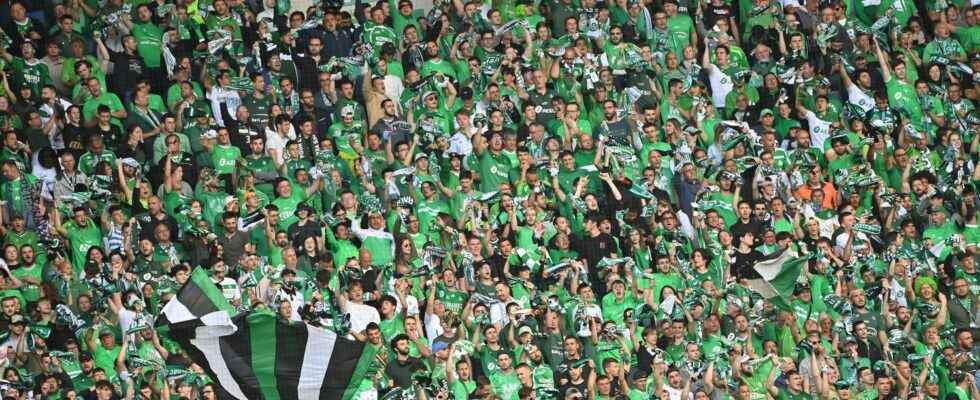In the silence of the Saint-Etienne night, their crestfallen faces and downcast eyes say a lot. The storm of the invasion of the field passed, the last supporters of ASSE complete their ninety-ninth step and leave the forecourt of the Geoffroy-Guichard stadium. Two hours before, their team ratified its relegation to Ligue 2, losing the barrage against Auxerre (1-1, 4-5 on penalties). For these irreducible, the hangover is likely to continue beyond this evening of May 29.
It’s over. The Greens are relegated.
– AS Saint-Etienne (@ASSEofficiel) May 29, 2022
Because at “Sainté”, the club “is a locomotive for the city and its territory”, explains Jean-Michel Roux, teacher in town planning at the University of Grenoble, originally from Forez. Walking the streets of the city center on a Sunday afternoon confirms his words. A stone’s throw from the cleaver match, ASSE monopolizes conversations and jerseys green the city.
Two hours before the AJA reception, Thomas Lassablière sets the tables in his bar tucked away in a narrow street in the city center. “I usually don’t open on Sundays. Except when there’s a match…”smiles this supporter of the Greens. “The city is interested in football, so it generates passion and employmenthe continues. I am the perfect example: a waitress comes to help me, when I am normally closed.” He hopes to be able to continue in Ligue 2, “but it’s expensive. A professional does not pay for TV subscriptions like an individual. Jobs are in danger of disappearing…”he warns.
Throughout the region, AS Saint-Etienne is a structuring object. “The agglomeration is extremely divided socially, between the city center and the outskirts, points out Vincent Béal, co-author of Sociology of Saint-Etienne. ASSE is the only point of consensus.”
“The club is a real common good. The boxes are not just for the bosses, they rotate with their employees.”
Jean-Michel Roux, urban plannerat Franceinfo: sports
But ASSE’s influence goes far beyond the borders of the Loire. For each home meeting, license plates from all over France gather in Sainté. “But will they come to Ligue 2, with matches on Monday evenings?”asks Julien Jeanroch, owner of the bar Les Poteaux Carrés. “On match nights, the restaurants and shops around Geoffroy-Guichard are fullconfirms Régis Juanico, deputy of the Loire. There, the hotels will experience a real shortfall, especially on the nights of people from afar…”

Saint-Etienne is one of those flowery cities of clichés. She is presented as poor, austere, dead. “The city does not know how to sell itselfsays Jean-Michel Roux. We still have the image of an industrial city, even though the mines closed in 1972! There are, however, resilient and innovative SMEs.” “In the popular imagination, Saint-Etienne is industry, but above all the football team”confirms sociologist Vincent Béal.
To restore its image, Saint-Etienne relies on design. Since 1998, a biennial has been organized on the theme. Ten years later, the Cité du design opened its doors. “We are the only creative French city of design recognized by Unesco”points out the mayor (LR) Gaël Perdriau.“In the 2000s, the mayor Michel Thiollière considered that football was too popular and stopped using it as a marker of identityemphasizes the sociologist Vincent Béal. Before, however, the club was a brand to promote the city.”
Even if all Ligue 2 matches are broadcast, their exposure is less. For at least a year, Saint-Etienne will do without derbies against OL or hot receptions from OM. “Design is all well and good, but who’s on TV every weekend? Football”, completes Julien Jeanroch, at the entrance to his restaurant on Place Jean-Jaurès. Behind him are examples of the famous “square posts” detrimental to the Greens during the C1 final in 1976. “My year of birth”he smiles.
Since then, ASSE has fallen into line. Until knowing Ligue 2 in the early 2000s. “The public followedremembers urban planner Jean-Michel Roux. The ‘industrial city’ side was able to develop a culture of losing, we were proud to see the last Greens of L2 against Gueugnon!”.
“I am convinced that we will recover from it. Saint-Etienne is a city to which we have never offered anything, it will seek to the flower of its forehead what it earns.”
Gaël Perdriau, LR mayor of Saint-Etienneat franceinfo: sport
Part of this identity could disappear with the probable sale of ASSE to David Blitzer, American owner of Crystal Palace. The club now belongs to an entrepreneur from Saint-Etienne, Roland Romeyer, and a businessman now based in Dubai, Bernard Caïazzo. The duo is strongly criticized by some of the supporters.
“They have had to clarify their intentions for more than a year”warns the city councilor, who describes the American track as “reassuring”. “We were quite surprised that the local tracks were dismissed out of handnotes the deputy Régis Juanico. ASSE should not become the ‘reserve’ of another club…”. In Ligue 2, Saint-Etienne will receive less revenue from TV rights and will have to lower its lifestyle. Layoffs are to be feared. The site will be, in any case, immense to restore pride to the green people.
